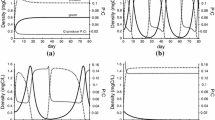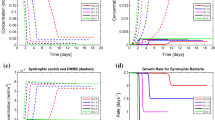Abstract
Biodegradation, the disintegration of organic matter by microorganism, is essential for the cycling of environmental organic matter. Understanding and predicting the dynamics of this biodegradation have increasingly gained attention from the industries and government regulators. Since changes in environmental organic matter are strenuous to measure, mathematical models are essential in understanding and predicting the dynamics of organic matters. Empirical evidence suggests that grazers’ preying activity on microorganism helps to facilitate biodegradation. In this paper, we formulate and investigate a stoichiometry-based organic matter decomposition model in a chemostat culture that incorporates the dynamics of grazers. We determine the criteria for the uniform persistence and extinction of the species and chemicals. Our results show that (1) if at the unique internal steady state, the per capita growth rate of bacteria is greater than the sum of the bacteria’s death and dilution rates, then the bacteria will persist uniformly; (2) if in addition to this, (a) the grazers’ per capita growth rate is greater than the sum of the dilution rate and grazers’ death rate, and (b) the death rate of bacteria is less than some threshold, then the grazers will persist uniformly. These conditions can be achieved simultaneously if there are sufficient resources in the feed bottle. As opposed to the microcosm decomposition models’ results, in a chemostat culture, chemicals always persist. Besides the transcritical bifurcation observed in microcosm models, our chemostat model exhibits Hopf bifurcation and Rosenzweig’s paradox of enrichment phenomenon. Our sensitivity analysis suggests that the most effective way to facilitate degradation is to decrease the dilution rate.












Similar content being viewed by others
References
Barsdate R, Prentki R, Fenchel T (1974) Phosphorus cycle of model ecosystems: significance for decomposer food chains and effect of bacterial grazers. Oikos 25:239–251
Bratbak G (1985) Bacterial biovolume and biomass estimations. Appl Environ Microbiol 49(6):1488–1493
Caron DA, Goldman JC, Andersen OK, Dennett MR (1985) Nutrient cycling in a microflagellate food chain: II. population dynamics and carbon cycling. Mar Ecol Prog Ser 24:243–254
Chitnis N, Hyman JM, Cushing JM (2008) Determining important parameters in the spread of malaria through the sensitivity analysis of a mathematical model. Bull Math Biol 70(5):1272–1296
Cross WF, Benstead JP, Frost PC, Thomas SA (2005) Ecological stoichiometry in freshwater benthic systems: recent progress and perspectives. Freshw Biol 50(11):1895–1912
Del Giorgio PA, Cole JJ (1998) Bacterial growth efficiency in natural aquatic systems. Annu Rev Ecol Syst 29(1):503–541
Der Yang R, Humphrey AE (1975) Dynamic and steady state studies of phenol biodegradation in pure and mixed cultures. Biotechnol Bioeng 17(8):1211–1235
Dhooge A, Govaerts W, Kuznetsov YA, Mestrom W, Riet A, Sautois B (2006) MATCONT and CL MATCONT: continuation toolboxes in matlab. Universiteit Gent, Belgium and Utrecht University, The Netherlands
Ekelund F, Rønn R (1994) Notes on protozoa in agricultural soil with emphasis on heterotrophic flagellates and naked amoebae and their ecology. FEMS Microbiol Rev 15(4):321–353
Fenchel T (1975) The quantitative importance of the benthic microfauna of an arctic tundra pond. Hydrobiologia 46(4):445–464
Fenchel T, Harrison P (1976) The significance of bacterial grazing and mineral cycling for the decomposition of particulate detritus. In: Symposium of the British Ecological Society, pp 285–299
Goldman JC, Caron DA, Andersen OK, Dennett MR (1985) Nutrient cycling in a microflagellate food chain: I. Nitrogen dynamics. Mar Ecol Prog Ser 24:231–242
Habte M, Alexander M (1975) Protozoa as agents responsible for the decline of Xanthomonas campestris in soil. Appl Microbiol 29(2):159–164
Herbert D, Elsworth R, Telling R (1956) The continuous culture of bacteria: a theoretical and experimental study. Microbiology 14(3):601–622
Hessen DO, Elser JJ, Sterner RW, Urabe J (2013) Ecological stoichiometry: an elementary approach using basic principles. Limnol Oceanogr 58(6):2219–2236
Hunt H, Cole C, Klein DA, Coleman DC (1977) A simulation model for the effect of predation on bacteria in continuous culture. Microb Ecol 3(4):259–278
Jiang L (2007) Negative selection effects suppress relationships between bacterial diversity and ecosystem functioning. Ecology 88(5):1075–1085
Kooi B, Boer M, Kooijman S (1997) Complex dynamic behaviour of autonomous microbial food chains. J Math Biol 36(1):24–40
Marine I (1986) Nutrient cycling in a microflagellate food chain: 111. Phosphorus dynamics. Mar Ecol Prog Ser 31:47–55
Marinescu M, Dumitru M, Lăcătuşu AR (2009) Biodegradation of petroleum hydrocarbons in an artificial polluted soil. Res J Agricult Sci 41(2):157–162
Monod J (1949) The growth of bacterial cultures. Ann Rev Microbiol 3(1):371–394
Nisbet B (1984) Nutrition and feeding strategies in protozoa. Croom Helm, London
Novick A, Szilard L (1950) Description of the chemostat. Science 112(2920):715–716
Rønn R, McCaig AE, Griffiths BS, Prosser JI (2002) Impact of protozoan grazing on bacterial community structure in soil microcosms. Appl Environ Microbiol 68(12):6094–6105
Salceanu PL (2011) Robust uniform persistence in discrete and continuous dynamical systems using lyapunov exponents. Math Biosci Eng MBE 8(3):807–825
Sherr BF, Sherr EB, Hopkinson CS (1988) Trophic interactions within pelagic microbial communities: indications of feedback regulation of carbon flow. Hydrobiologia 159(1):19–26
Singleton P, Sainsbury D et al (1981) Introduction to bacteria. Wiley, Chichester
Smith HL, Waltman P (1995) The theory of the chemostat: dynamics of microbial competition, vol 13. Cambridge University Press, Cambridge
Sterner RW, Elser JJ (2002) Ecological stoichiometry: the biology of elements from molecules to the biosphere. Princeton University Press, Princeton
Stout JD (1980) The role of protozoa in nutrient cycling and energy flow. In: Advances in microbial ecology. Springer, New York, pp 1–50
Wang H, Jiang L, Weitz JS (2009) Bacterivorous grazers facilitate organic matter decomposition: a stoichiometric modeling approach. FEMS Microbiol Ecol 69(2):170–179
Wang H, Smith HL, Kuang Y, Elser JJ (2007) Dynamics of stoichiometric bacteria–algae interactions in the epilimnion. SIAM J Appl Math 68(2):503–522
Author information
Authors and Affiliations
Corresponding author
Rights and permissions
About this article
Cite this article
Kong, J.D., Salceanu, P. & Wang, H. A stoichiometric organic matter decomposition model in a chemostat culture. J. Math. Biol. 76, 609–644 (2018). https://doi.org/10.1007/s00285-017-1152-3
Received:
Revised:
Published:
Issue Date:
DOI: https://doi.org/10.1007/s00285-017-1152-3
Keywords
- Biodegradation
- Organic matter
- Microorganism
- Stoichiometry
- Chemostat
- Persistence
- Sensitivity analysis
- Bifurcation




